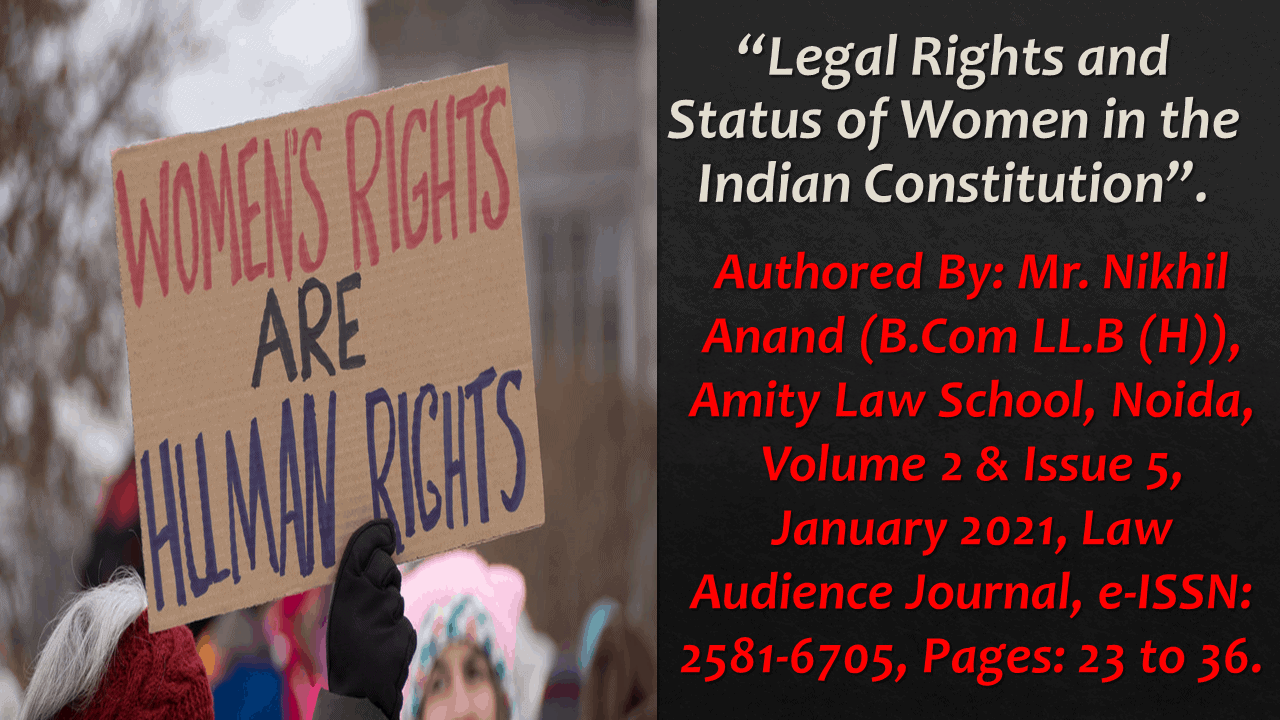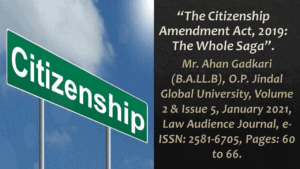Click here to download the full paper (PDF)
Authored By: Mr. Nikhil Anand (B.Com LL.B (H)), Amity Law School, Noida.
Click here for Copyright Policy.
Click here for Disclaimer.
I. ABSTRACT:
“The Constitution of India guarantees the constitutional and legal rights of women. Women are said to be the cradle of human progress and civilization. They are an essential role in our society. They are requisite of any family. The rights available to women in India divided into two classes, which are distinguished as Sacred rights and Statutory rights. Sacred rights are those granted in various provisions of the constitution. Statutory rights, therefore, are those outlined in many laws (statutes) of Parliament and state law. Women, a daughter, a wife, a mother, a grandmother, in general, the woman is the key to a family.
The world can never be complete without a woman. The law is a set of rules to control the behaviour of people. In the closing speech of the assembly debate, Dr BR Ambedkar said- “we will enter a life full of contradictions”. We will have equality in politics and social and economic life, and we will have inequalities. Since the beginning, women have been considered a vulnerable part of society.
They have been victims of crimes such as rape, paedophilia, female fetish, dowry, domestic violence, child marriage, pitching, acid. She had the right to live only under the skin of her husband and father. Laws passed to protect the lives of women from violence in their families and societies and to grant them their rights.
The constitution not only guarantees the equality of women but also empowers the state to take affirmative action on behalf of women. Within the framework of a democratic regime, our development laws, policies, plans and programs are aimed at promoting women in various fields. That is why they must be safe and respected in society. Their role in building a family and community cannot be reduced or diminished.
In this article, the researcher will talk about the Diagramming of Violations of Women’s Rights and legal status of women and how the central law guarantees, among other things, equity under the watchful eye of the law and the equivalent certainty of the law.”
II. INTRODUCTION:
Legally speaking, a woman is considered a woman after her childhood and adolescence, which means that a girl is essentially a woman after having gone through her youth. The government of India has proceeded laws to give women the same status in our country and protect their lives from multiple acts of violence and crime[1]. The Constitution of India offers Indian citizens fundamental rights and duties. All citizens of this country also have these rights and obligations.
The Constitution of India[2] guarantees to all Indian women:
- Equality (Article 14),
- No discrimination by the State Authority (Article 15(1)),
- Equality of opportunity (Article 16),
- Equal pay for equal work in every term (Article 39(d)),
Besides, it allows the state to take special precautions for women and children (article 15(3)) and renounces practices derogatory to the dignity of women (article 51(A)(e) also allows the provision of working conditions and maternity safe and humane throughout the State (Article42). Studies have shown that[3] women had the same status and authority in ancient times and the early Vedic period. Around 500 B.C., however, the quality of women began to decline and, with the Islamic invasion of Babur, the Mughal Empire and Christianity, women’s freedom and rights deteriorated as a result. The situation of Indian women in society[4] continued to deteriorate in the Middle Ages when the prohibition of child marriage and remarriage of widows became part of the social life of some communities in India. Women also contributed to the struggle for independence in India. The condition of women began to improve with British rule. The women of India are now fully involved in areas like education, sports, politics, media, arts and culture, services, science and technology, etc. Indira Gandhi, who give out as Prime Minister of India for a total of fifteen years, is the world’s oldest Prime Minister. The government of India has several functions and agreements in favour of women.
III. LEGAL STATUS OF A WOMAN IN INDIA:
Women in India enjoy legal protection to ensure their economic, social and cultural life. These are some measures that reflect the efforts of the Government of India[5] to save the lives of women.
- Dowry Prohibition Act 1961,
- Maternity Benefit Act 1861, Births, Deaths & Marriages Registration Act 1886,
- Medical Termination of Pregnancy Act 1971,
- National Commission for Women Act 1990,
- Pre-natal Diagnostic Techniques (Regulation and Prevention of Misuse) Act 1999,
- Protection of Women from Domestic Violence Act 2005,
- Sexual Harassment of Women at Work Place (Prevention, Prohibition & Redressal) Act 2013,
- Hindu Widows Remarriage Act 1856,
- Muslim women (protection of rights on divorce) Act 1986,
- Guardians and Wards Act of 1890,
- Indian Penal Code 1860,
- Christian Marriages Act, 1872, etc.
IV. MAPPING THE VIOLATIONS OF WOMEN’S RIGHTS:
The areas that violate women’s rights in India:
IV.I Missing Women and Girls:
In many developing countries, the term “missing women” has been used when they discovered that women make up less of the population than men. Women and girls are disappearing in many states in India. One of the main reasons for his death is human trafficking. When girls trafficked, they become highly exploited and without food or other basic needs. Girls from low-income families sold through intermediaries to men in northern India, where the problem of gender imbalance is very evident. Cut off from that; there have also been cases of women disappearing from their marital home. The eventuality of violent and criminal acts against women inside and outside the house mainly leads to their absence.
IV.II Dowry Death:
In India, the number of women killed by dowry in their matrimonial home has increased. Dowry disputes have become a severe problem. In 2012, around 8,233 newly married women were killed for dowry, the National Office of Criminal Records reported[6]. Taking and giving a dowry is a crime in the country. The “Dowry Prohibition Act” has not been adequately applied in India. We learn that in most states, neither the dowry officers nor they have required to keep records of things given and received.
IV.III Domestic Violence:
There has been the ubiquity of domestic violence in India, despite the Protection of Women from Domestic Violence Act, 2005. It is when a woman experiences violent and criminal acts at the hands of their husbands, in-laws, fathers, brothers or other family members. Which includes, verbal abuse, physical abuse, and many things. There are many reasons why women experience domestic violence in their marital home, cannot do housework properly, have financial problems, want to have a male child, ignorance and illiteracy among women[7]. Experiencing problems, Basic needs and requirements, health problems and feelings of protest and resentment.
IV.IV Sati:
Sati is a practice used to detain widows at their husbands’ funerals. This practice was eradicated by the social reformer Raja Ram Mohan Roy. This continues even after colonial India. The Sati Prevention Law has been passed, which declares the practice of sati as a crime for which offenders can also be sentenced to death. The law states that the worship of sati is also prohibited from building a temple and worshipping deceased women as a deity. However, some sectors of the individual consider law as an interference in the authority of the dictatorship of their religion.
IV.V Child Marriage:
Child marriage occurs when girls under 18 are married and boys under 21. Child marriage is seen as a practice that deprives girls of their childhood. They find it difficult to get an education, enrol in school, enjoy other children’s activities, and improve their abilities and skills. It also harms the social, psychological and emotional development of the child. When girls are victims of domestic violence in their marital home, they feel anxious and worried. The 2006 Child Marriage Act prohibits the marriage of boys and declares 18 as the minimum age of marriage for girls and 21 for boys.
IV.VI Sexual Harassment at Workplace:
The contingency of sexual harassment at the workplace is observed the most damaging problem that hinders its progression. In India, women face discrimination in terms of wages and salaries for their work. It is a reality for urban and rural areas that they are abused for promotion and advancement in employment[8]. Women entrepreneurs tend to have more significant problems obtaining financing and resources to start a business. Sexual harassment in the workplace disturbs the psychological attitude of women. She is forced to quit her job even though she is financially weak and needs a job.
IV.VII Rape:
The rape cases have increased in India, dramatically in the last ten years. Rape is usually caused by enmity, hostility, resentment, or other reasons.
IV.VIII Acid Attack:
A survey by the Thomas Reuters Foundation shows that India is the fourth most dangerous place in the world for women of any class, caste, creed or religion to fall victim to this cruel form of violence and decadence[9]. In India, acid attacks on women who dare to reject a man’s marriage proposal or divorce are a form of revenge. Cheap and readily available, acid is the fastest way to ruin a woman’s life. Increase the number of acid attacks.
V. FUNDAMENTAL RIGHTS TO IMPROVE THE STATUS OF WOMEN:
The articles in Part III[10] of the Constitution of India refer to fundamental rights aimed at improving the quality of women and providing them with equal opportunities, as indicated below:
V.I Article 14 of the Constitution of India:
According to Article 14 of the Constitution of India, all people, including women, are similar in terms of rights and are also entitled to equal protection under the laws of the territorial jurisdiction of India[11]. It shows that all people, regardless of gender, should be treated equally in the same circumstances. The state must not discriminate between one person, and another and the law must be applied equally.
V.II Article 15 of the Constitution of India:
Article 15 of the Constitution of India allocate with the prohibition of discrimination: it prohibits the state from discriminating against any citizen, including women, based on their race, gender, religion, place of birth and socio-economic origin. It inaugurates that all citizens have the right to enjoy the same rights in terms of an outbreak to shops, hotels, restaurants, banks, infrastructure, public places, etc.
V.III Article 16 of the Constitution of India:
According to Article 16 of the Constitution of India, including all citizens, women have equal opportunities in public employment regardless of their gender, race, caste, ethnicity, religion and religion of socio-economic origin.
V.IV Article 17 of the Constitution of India:
According to Article 17 of the Constitution of India, the system of untouchability was abolished, and the Parliament passed the Untouchability (Criminal Offenses) Act 1955. The law was amended by the Untouchability (Criminal Offenses) Amendment Act of 1976 to make the law stricter and eliminate the untouchability of society.
V.V Article 19 of the Constitution of India:
According to Article 19 of the Constitution of India, all citizens including women have the right to freedom of expression, to assemble peacefully and without arms, to form unions or associations, to move freely around the country, to live or settle in any part of the country and any profession or any legitimate trade or business at your will.
V.VI Article 21 of the Constitution of India:
According to the procedure established by law, none can be deprived of his life or personal freedom. This right to life, the right to dignity, the right to privacy, etc. are included. Domestic violence against women is also a derogation from Article 21 of the Constitution of India as it undermines the self-esteem and dignity of the women who suffer.
V.VII Article 21A of the Constitution of India:
According to Article 21A of the Constitution of India, the state must provide all children between the ages of six and fourteen with free and compulsory education as determined by law.
V.VIII Article 24 of the Constitution of India:
Under Article 24 of the Constitution of India, it prohibits the employment of boys, especially girls, the work of children under 14 years of age in a factory, quarry or other dangerous occupation.
VI. SAFETY FRAMEWORK:
The Indian government has various laws to protect and preserve the life of a woman in the country. Despite these laws, rules and regulations, women’s lives are still not entirely safe. In-equality between men and women is present in all regions of the country, whether in terms of education, governance or economic opportunities.
Some up-to-date statistics on women are included:
- In 2010 (National Office of Criminal Records) a girl was murdered every hour for demanding a dowry[12].
- About 45% of Indian girls marry before the age of 18 (International Centre for Women’s Studies)[13].
- One in five Indian women, dies in pregnancy or childbirth (WHO)[14].
VII. SPECIFIC LURE FOR WOMEN:
VII.I Reserve for Women in Local Self-Government:
The 73rd law amending the Constitution, passed by Parliament in 1992, guarantees women in all elected positions in local bodies one-third of the total number of seats whether in rural or urban areas.
VII.II National Action Plan for Girls (1991-2000):
The action plan is to ensure the survival of Girls’ safety and development with the ultimate goal of creating a better future for the girl.
VIII. JUDICIAL APPROACH TO GENDER EQUALITY:
Supreme Court in Muthamma v. Union of India[15], and Air India v Nargesh Mirza[16], which impose discriminatory conditions of service that allow workers to request leave and denial before the marriage. Marriage is required. The right of pregnant women to work.
In Vishaka v. State of Rajasthan[17], the Supreme Court has determined that the equality of workers can be seriously compromised when women are exposed to gender-based violence, such as sexual harassment in the workplace. For this reason, the Supreme Court has issued guidelines to ensure that women’s working conditions are equal and are protected from sexual harassment. Vishaka, a public interest class-action lawsuit, appeared before the Supreme Court of India to prevent sexual harassment of female workers in all workplaces by individual social workers and non-governmental organizations (NGOs). They complained that the workers were sensitive to this, but neither the Legislative Power nor the Executive Branch took effective preventive measures in this regard. Therefore, the plaintiff turned to the Supreme Court to enforce the fundamental rights of women guaranteed in the Constitution.
In cases involving public employment[18], the courts have repealed discriminatory provisions that benefit men and impose disabilities on women.
IX. DPSP (DIRECTIVE PRINCIPLE OF STATE POLICY) AND WOMEN:
According to the 1950 Constitution of India, the direct principle of state policy reflects the governance that India is a democratic welfare state. This policy provides for equal rights at work, equal pay for similar work, dignified and respectful livelihoods for men and women, which are guaranteed by the guiding principles of state policy. Part IV of the Constitution[19] containing Articles 38, 39(a) (d) and (e), 42, 44 and 45 deal with the welfare and development of women. According to Article 39 (a), the state must guide its policy in such a way as to guarantee citizens, men and women the right to an adequate means of subsistence. This article grants the same rights to all citizens, regardless of fair food. Article 39 (d) of the Constitution establishes that all three must have equal pay for men and women for similar work. The state thus operates its policy within the framework of the constitutional obligation to guarantee equal pay for equal work for men and women.
In Randhir Singh v. Union of India[20], the apex court has ruled that the principle of “equal work” is not anchored as a fundamental right in the Constitution, but it is undoubtedly a constitutional objective. Article 39 (d), the principle of equal pay for equal work, differs from these articles and can be adequately applied in the case of unequal pay due to lack of classification or irrational classification of different types of equal pay, previously preparing rules for similar jobs with the same employer. In the present victim, the Supreme Court ruled that the principle of “equal pay and equal work”, although not a fundamental right, is actually a constitutional objective and, therefore, can be implemented through constitutional measures under article 32 of the Constitution.
Closely, In State of Haryana v. Rajpal Sharma[21], the Supreme Court has ruled that teachers working in private schools in Haryana state are entitled to the same salary and expense benefits as public school teachers. If this type of work is not the same, it does not matter if the men are better paid. However, if the work is of the same kind, men and women should be paid equally without discrimination.
X. MAINTENANCE RIGHTS OF WOMEN:
Women’s right to maintenance is also precious, as not all women, be the girls or women, have independent means of subsistence. The Hindu Adoption and Maintenance Act of 1956 allows for the support of a widowed Hindu daughter-in-law, children and elderly relatives. The husband has to stay with his wife as he has to give maintenance[22]. The father-in-law must support a widowed daughter-in-law, and a Hindu must raise his legitimate or illegitimate children and himself or the elderly or parents. The limits of these rights are established in section 18, 19 and 20 of the law as mentioned earlier. Muslim women also have the right to be restrained by their husbands.
These rights are obtained under personal law and enforced in court. In addition to these rights, Section 125 of the Code of Criminal Procedure, 1974 provides a summary and quick resource for obtaining maintenance. Under section 125, a woman who cannot take care of herself, her minor children, is married or whose parents cannot take care of her needs can apply for alimony in court. This is a very cheap and quick solution, and although the court-ordered amount is challenging to recover, perpetrators often go to great lengths to obtain relief. For the most part, it is abandoned women who seek cures in this way and benefit from them.
XI. ANALYSIS:
Today women’s rights are recognized as human rights, but this does not guarantee their implementation. For better results and the full realization of human rights for all people, great effort is required. The current cultural and social perception of the population must change so that the new progressive legislative measures have a positive impact on the protection of women’s rights. There is no doubt that the law regards it as a powerful tool for any social change, but it still has certain limits. You cannot create a new society as law. Because the law is only a fraction of the reform event. We need to find the source of the problem and expand it. Traditional practices that have stripped society of its colours must be seen and understood as found to be detrimental to the existence of an ordinary woman.
In our community, women are grasping as the weakest section and have therefore been submissive for centuries. They have been accused of numerous atrocities. The condition remains the same even though people believe that the women were released. Although much remains to be done to achieve real liberation. Until now, the abolition of violence against women outside the home has been considered a crime by strangers, but unfortunately[23], the most brutal and heinous crimes against women have been committed by those who are not close to them and are not the trusted people. Still, some crimes are made by their close ones only. Marriages are said to take place in heaven, but some women go into hellish conditions after the wedding. Many laws and laws have been passed regarding violence against women, such as dowry, domestic violence, and cruelty towards women in your own home.
XII. WOMEN EMPOWERMENT SCHEMES[24]:
- Beti Bachao Beti Padhao Scheme,
- One Stop Centre Scheme,
- Women Helpline Scheme,
- UJJAWALA: A Comprehensive Scheme for Prevention of trafficking and Rescue, Rehabilitation and Re-integration of Victims of Trafficking and Commercial Sexual Exploitation,
- Working Women Hostel,
- Ministry approves new projects under Ujjawala Scheme and continues existing projects,
- SWADHAR Greh (A Scheme for Women in Difficult Circumstances),
- Support to Training and Employment Programme for Women (STEP),
- NARI SHAKTI PURASKAR,
- Awardees of Stree Shakti Puruskar, 2014 & Awardees of Nari Shakti Puruskar,
- Awardees of Rajya Mahila Samman & Zila Mahila Samman,
- Mahila police Volunteers,
- Mahila E-Haat,
- Mahila Shakti Kendras (MSK),
- NIRBHAYA,
XIII. CONCLUSION:
The Indian constitution grants women the same rights as men, but strong patriarchal traditions persist, shaped by centuries-old customs of women’s lives that still exist in society. In most Indian families, a girl is seen as an obligation and is conditioned to believe that she is inferior and inferior to men. To achieve the constitutional goal of equality and social justice for historical reasons, women’s rights are guaranteed at the national level to ensure the development of women through socio-economic and educational opportunities. In recent decades, they have evolved in your favour through affirmative action in education, employment, governance, and other areas. Despite all this, it has become mainstream news in newspapers and other magazines that women face a lot of problems for crimes committed against them in one form or another. There is still maleism in our society. Illiteracy is the main cause of all this damage. Some changes have been made and adopted in many ways but then also despite the evolution of education and other notable changes in Indian society, Indian women are still in the dark. The struggle of a woman’s life is more than that of a man. Respect for women is respect for the world. He who abuses a woman is the most cowardly. Women are not weak, they are dedicated to their families, but that does not mean that they cannot work outside the home. Sometimes they are better than academic or official performance.
[1] Report No. 37820, Crime, Violence, and Development: Trends,
Costs, and Policy Options in the Caribbean, available at https://www.unodc.org/pdf/research/Cr_and_Vio_Car_E.pdf.
[2] The Constitution of India, available at https://www.india.gov.in/sites/upload_files/npi/files/coi_part_full.pdf.
[3] Researched by Author.
[4] Preeti Narula, Role of Women in Society, available at https://fairgaze.com/interested-article/role-of-women-in-society.htm.
[5] Sandra Day O’Connor, The Legal Status of Women: The Journey toward Equality, available at https://www.jstor.org/stable/1051513.
[6] See Table 5(A) Crime Head-wise Cases Registered under Crime against Women during 2011 – 2015 and Percentage Variation in 2015 over 2014, available at https://ncrb.gov.in/sites/default/files/Compendium/Compendium-15.11.16.pdf.
[7] All India Democratic Women’s Association. Gender-Just Laws.
[8] Why India Needs the Women’s Reservation Bill, available at https://www.oxfamindia.org/policybrief/why-india-needs-women’s-%20reservation-bill.
[9] Belinda Goldsmith & Meka Beresford, Exclusive: India Most Dangerous Country for Women with Sexual Violence Rife – Global Poll, available at https://www.reuters.com/article/us-women-dangerous-poll-exclusive/exclusive-india-most-dangerous-country-for-women-with-sexual-violence-rife-global-poll-idUSKBN1JM01X?utm_campaign=trueAnthem:+Trending+Content&utm_content=5b31dd8e04d30167db615da4&utm_medium=trueAnthem&utm_source=twitter.
[10] Part 3 Constitution of India: Fundamental Rights, available at https://www.latestlaws.com/bare-acts/central-acts-rules/coi-part-3-fundamental-rights/.
[11] Agarwal, H.O. International Law and Human Rights. Allahabad: Central Law Publications.
[12] Dean Nelson in New Delhi, Woman killed over dowry ‘every hour’ in India, available at https://www.telegraph.co.uk/news/worldnews/asia/india/10280802/Woman-killed-over-dowry-every-hour-in-India.html.
[13] Child marriage, available at https://www.unicef.org/rosa/what-we-do/child-protection/child-marriage.
[14] Scroll Staff, Every Five Minutes, At Least One Woman Dies Of Pregnancy Or Childbirth Complications In India: WHO, available at https://scroll.in/latest/810102/every-five-minutes-at-least-one-woman-dies-of-pregnancy-or-childbirth-complications-in-india-who.
[15] (1979) 4 SCC 260.
[16] AIR 1981 SC 1829.
[17] AIR 1997 SC 3011.
[18] Public Employment Cases, available at https://indiankanoon.org/search/?formInput=public%20employment%20.
[19] Pandey, J.N. (2016), Constitutional Law of India. Allahabad: Central Law Agency.
[20] Gautam Bhatia, Equal Pay for Equal Work: Statute and Constitution, available at https://indconlawphil.wordpress.com/2017/04/09/equal-pay-for-equal-work-statute-and-constitution/.
[21] AIR 1985 SC 1263: 1985 LablC 1500: 1985 (1) SCALE 1088: 1985 Supp (1) SCC 72: 1985 (17) UJ 615 SC.
[22] Rahman, Z. (2005), Women and Society. Delhi: Kalpaz Publications.
[23] Analysis by Author.
[24] Women Empowerment Schemes, available at https://wcd.nic.in/schemes-listing/2405.



